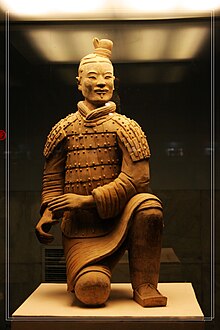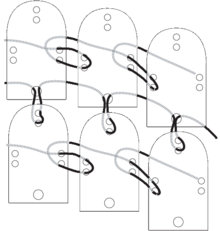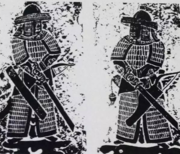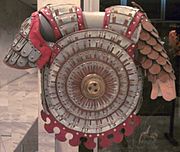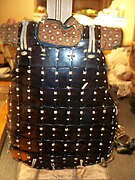
Armour or armor is a covering used to protect an object, individual, or vehicle from physical injury or damage, especially direct contact weapons or projectiles during combat, or from a potentially dangerous environment or activity. Personal armour is used to protect soldiers and war animals. Vehicle armour is used on warships, armoured fighting vehicles, and some combat aircraft, mostly ground attack aircraft.

A cuirass is a piece of armour that covers the torso, formed of one or more pieces of metal or other rigid material. The word probably originates from the original material, leather, from the French cuirace and Latin word coriacea. The use of the term "cuirass" generally refers to both the breastplate and the backplate pieces; whereas a breastplate only protects the front, a cuirass protects both the front and the back of the wearer.

Plate armour is a historical type of personal body armour made from bronze, iron, or steel plates, culminating in the iconic suit of armour entirely encasing the wearer. Full plate steel armour developed in Europe during the Late Middle Ages, especially in the context of the Hundred Years' War, from the coat of plates worn over mail suits during the 14th century, a century famous for the Transitional armour, in that plate gradually replaced chain mail.

Kabuto is a type of helmet first used by ancient Japanese warriors that, in later periods, became an important part of the traditional Japanese armour worn by the samurai class and their retainers in feudal Japan.

A brigandine is a form of body armour from the late Middle Ages and up to the early Modern Era. It is a garment typically made of heavy cloth, canvas, or leather, lined internally with small oblong steel plates riveted to the fabric, sometimes with a second layer of fabric on the inside.
Korean armour is armour that was traditionally used in ancient times by Koreans, those fighting in and on behalf of Korea, or Koreans fighting overseas. Examples of armour from the Korean Peninsula date back to at least the Korean Three Kingdoms period. Depending on the tactical situation, Korean armour also included horse armour and other kinds of early anti-ballistic armour before the 20th century.

Scale armour is an early form of armour consisting of many individual small armour scales (plates) of various shapes attached to each other and to a backing of cloth or leather in overlapping rows. Scale armour was worn by warriors of many different cultures as well as their horses. The material used to make the scales varied and included bronze, iron, steel, rawhide, leather, cuir bouilli, seeds, horn, or pangolin scales. The variations are primarily the result of material availability.

Chinese armour was predominantly lamellar from the Warring States period onward, prior to which animal parts such as rhinoceros hide, rawhide, and turtle shells were used for protection. Lamellar armour was supplemented by scale armour since the Warring States period or earlier. Partial plate armour was popular from the Eastern and Southern dynasties (420–589), and mail and mountain pattern armour from the Tang dynasty (618–907). Chain mail had been known since the Han dynasty, but did not see widespread production or battlefield use, and may have seen as "exotic foreign armor" used as a display of wealth for wealthier officers and soldiers. During the Ming dynasty (1368–1644), brigandine began to supplant lamellar armour and was used to a great degree into the Qing dynasty (1644–1912). By the 19th century most Qing armour, which was of the brigandine type, were purely ceremonial, having kept the outer studs for aesthetic purposes, and omitted the protective metal plates.
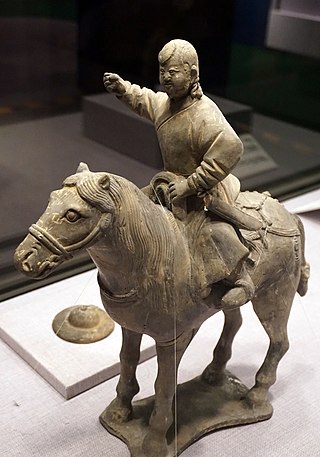
Mongolian armour has a long history. Mongol armour drew its influence from Chinese, Middle Eastern, and Central Asian styles. Most Mongolian armour was scale and lamellar made of hardened leather and iron, laced together onto a fabric backing, sometimes silk. Mail armour was also sometimes used, but was rare, probably due to its weight and difficulty to repair. Mongol archers demanded the armour be light enough so that when riding, it didn't interfere with their mobility.

The ō-yoroi (大鎧) is a prominent example of early Japanese armor worn by the samurai class of feudal Japan. The term ō-yoroi means "great armor".

Dō-maru (胴丸), or "body wrap", is a type of chest armour that was worn by the samurai class of feudal Japan. Dō-maru first appeared in the 11th century, as an armour for lesser samurai and retainers. Like the ō-yoroi style it became more common in the Genpei War at the end of the 12th century.
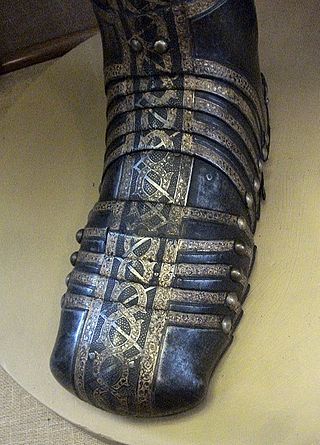
A lame is a solid piece of sheet metal used as a component of a larger section of plate armor used in Europe during the medieval period. It is used in armors to provide articulations or the joining of the armor elements. The size is usually small with a narrow and rectangular shape. Multiple lames are riveted together or connected by leather straps or cloth lacing to form an articulated piece of armor that provides flexible protection. The armor worn by the samurai class of feudal Japan used lames in the construction of many of their individual armor parts. The Japanese term is ita, which can both refer to the lame or its borderings.
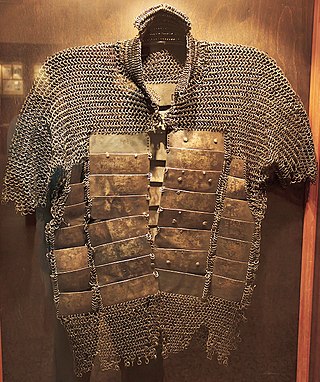
Mail and plate armour is a type of mail with embedded plates. Armour of this type has been used in the Middle East, North Africa, Ottoman Empire, Japan, China, Korea, Vietnam, Central Asia, Greater Iran, India, Eastern Europe, and Nusantara.
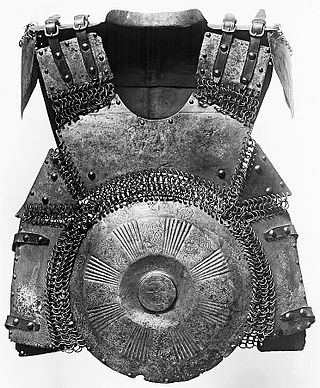
Mirror armour, sometimes referred to as disc armour or as chahār-āyneh or char-aina, was a type of cuirass used mainly in Asia, the Middle East, and Eastern Europe; including India, Persia, Tibet, Russia, and the Ottoman Empire. It literally translates to "four mirrors" which is a reflection of how these pieces looked, which resembles four metal discs or rectangular armour plates. Mirror armor was used in some cultures up to the 20th century.

Scholars agree that Japanese armour first appeared in the 4th century, with the discovery of the cuirass and basic helmets in graves. During the Heian period (794–1185), the unique Japanese samurai armour ō-yoroi and dō-maru appeared. The Japanese cuirass evolved into the more familiar style of body armour worn by the samurai known as the dou or dō, with the use of leather straps (nerigawa), and lacquer for weatherproofing. Leather and/or iron scales were also used to construct samurai armours, with leather and eventually silk lace used to connect the individual scales (kozane) of these cuirasses.

Laminar armour is an armour made from horizontal overlapping rows or bands of, usually small, solid armour plates called lames, as opposed to lamellar armour, which is made from individual armour scales laced together to form a solid-looking strip of armour. Prominent examples of such armour are lorica segmentata of Ancient Rome and certain versions of samurai armour.

Tatami (畳具足), or tatami gusoku, was a type of lightweight portable folding Japanese armour worn during the feudal era of Japan by the samurai class and their foot soldiers (ashigaru). The Tatami dō or the tatami katabira were the main components of a full suit of tatami armour.

The klivanion or klibanion was a Byzantine lamellar cuirass made of metal plates sewn on leather or cloth, with plates protecting the shoulders and the back. It is said that the name derives from the Greek klivanos (κλίβανος), meaning "oven", because this cuirass tended to get unbearably hot when worn in the sun. It was part of the armour of the Byzantine heavy cavalry. This cavalry called the kataphraktoi also wore this with a thickly padded surcoat epilorikion as added covering. Considered one of the three best armors together the thorax and zava-lorikion, it was also worn by the Taghmatics and the Byzantine Imperial Guards.

Dō or dou (胴) "breastplate, cuirass" is one of the major components of Japanese armour worn by the samurai and ashigaru or foot soldiers of feudal Japan.
Vietnamese armour is military body armour made in the region of Vietnam.
